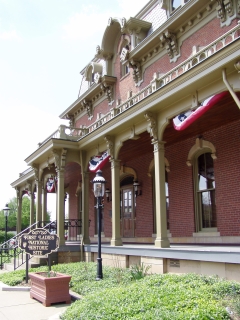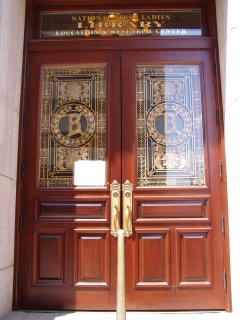NPS Website; Local Website
 WHAT IS IT?
WHAT IS IT?Former home of First Lady Ida Saxton McKinley converted into bookstore and museum of First Lady memorabilia and former City National Bank Building converted into research library and exhibition space.
BEAUTY (2/10)
Neither building is particularly striking. The Saxton McKinley house is a three-story brick building which sits on the corner next to a small concrete park. The Bank Building looks like a bank building – tall, slender, white stone, large door.
Inside, there is not much to look at, especially since the one cool area of the site, the National First Ladies' Library Education and Research Center, cannot be accessed without an appointment. You will have to take our words for it – no pictures are allowed.
This is the first time we have been forbidden to take photographs of any kind. At the Metropolitan Museum of Art, we were able to photograph 14th century tapestries, Egyptian mummies and the silver chalice once thought to be the Holy Grail. But for some reason, at First Ladies NHS, the replica of Nancy Reagan’s inaugural dress and Pat Nixon’s purse were off limits.
HISTORICAL INTEREST (3/10)
The First Ladies National Historic Site was established in October 2000. Prior to its designation as a National Historic Site, the Ida Saxton McKinley House was home to the National First Ladies’ Library, a nonprofit organization which still manages the site.
The Saxton McKinley house is the only residence with direct historical ties to President William McKinley remaining in his hometown of Canton. It was the family home of McKinley's wife, Ida, and he and his wife lived in the house between 1878-1891.
CROWDS (2/10)
We were the youngest visitors by at least three decades. The majority of the visitors we saw were older women traveling in clusters. A few older gentlemen were scattered here and there. Didn’t exactly make for a lively bunch.
EASE OF USE/ACCESS (4/5)
The older crowd clearly appreciated the ramps and elevators that allowed them access to every level in both buildings. There are no clearly marked signs that lead to the small but free parking lot behind Ida McKinley’s house. Instead, brown signs direct you to a fee parking garage or incorrectly into a pass coded lot which is strictly for First Ladies’ employees.
When we called ahead to check the tour schedule, we were encouraged to make a reservation. The days before and after our planned visit were already booked. No more than 15 people are allowed on each tour.
The National First Ladies' Library Education and Research Center is currently open by appointment only.
 CONCESSIONS/BOOKSTORE (2/5)
CONCESSIONS/BOOKSTORE (2/5)One would think that this store would be filled with First Ladies’ biographies and autobiographies. Accounts of their contributions to history and society. No such luck. Hilary Clinton’s autobiography is there, as are children’s books, paper doll books replicas of china patterns, Victorian knick-knacks and flyers announcing a Cokie Roberts speaking engagement. No copy of the United Nations Declaration of Human Rights, which Eleanor Roosevelt felt was her most important achievement. Not nearly enough material on women’s history.
We were extremely disappointed by the absence of First Lady dolls and bobble heads that we found in other National Park Bookstores.
COSTS (1/5)
The buildings and the land are owned by the National Parks Service. Everything in them remains the property of the National First Ladies’ Library, an “operating partner” of the Parks Service. Because the collection is privately owned, a fee can be charged. Some might find $7 a fair price for a retrospective of First Ladies’ dresses and dishes.
We expect something a little more substantial for our money.
RANGER/GUIDE TO TOURIST RATIO (2/5)
No Rangers, but a proliferation of costumed interpreters who took tour groups around both houses. These volunteers are kind and helpful, but lack the historical knowledge we were seeking. We can see the dresses just fine by ourselves, thanks. The lack of a Ranger or any person we felt we could interrogate increased our frustration with this site.
TOURS/CLASSES (3/10)
The McKinley House and Bank can only be seen as part of a $7 tour led by volunteers, not Rangers. You will walk through a ballroom lined with photos and portraits of the First Ladies, a few refurbished rooms and display cases holding dresses and items belonging to the First Ladies.
Not being huge decorative arts fans to begin with, these offerings held no appeal to us, especially absent a Ranger’s interpretation.
Our experience runs in sharp contrast to our tour at the James A. Garfield National Historic Site, which told us so much about Lucretia Garfield. The entire house is a testament to her tastes and her devotion to her family, particularly the library she created in memory of her husband. The pump house, windmill and gasholder on the estate tell the story Lucretia success as a businesswoman; she found natural gas on her land after her husband passed away, giving the family far more wealth than they had ever enjoyed.
FUN (2/10)
We were bored to tears and frustrated with our very sweet, costumed docent. The entire time we were there, we were wishing we were some place else.
WOULD WE RECOMMEND? (2/10)
No. Time is better spent at the Eleanor Roosevelt NHS or at any other Historical Site dedicated to their husbands, the Presidents. At least there you will be able to see more facets of these women’s personalities and accomplishments. There is more to life than dresses and dishes and pretty rooms. The First Ladies clearly knew that. Such a shame that the Site “devoted to educating people about the contributions of First Ladies and other notable women in history” falls so short of its mission.
The Virtual Library, however, is worth perusing. Stay at home and go to www.firstladies.org to find a comprehensive annotated bibliography of books, manuscripts, articles and other materials about and by the First Ladies, although more hyperlinks to actual source documents would make the site more useful.
TOTAL 23/80
www.usa-c2c.com
© 2004-06